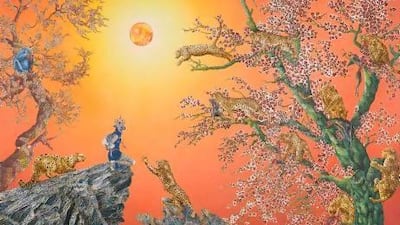His opulent, extravagantly colourful paintings are full of strange figures and flora, telling intricate stories steeped in poetry, religion and mythology. They make little nods to the works of the Old Masters of European painting: Hieronymus Bosch, Hans Holbein.
But look closer and there's something altogether more intriguing in Raqib Shaw's work. Thanks to growing up in Kashmir, the techniques, styles and influences derived from eastern decorative art, Persian miniatures and the lavish Mughal empire have vibrantly collided with his art training at London's Central Saint Martins College.
The absorbing melting pot of influences and ideas in Shaw's work has always made him one to watch. But it was the sale of Garden of Earthly Delights III - with its very evident nod to Bosch - for a staggering US$5.49 million (Dh20.2m) in 2007 which signalled the arrival of a genuine international talent. His work has since been shown at solo shows in New York, Vienna, London and Paris, and appeared at exhibitions in San Francisco, Kiev, Singapore, Milan, Sydney, Dubai and Abu Dhabi. He is, without question, one of India's foremost contemporary artists.
True, 38 might seem a bit early for a career-spanning retrospective, but Shaw's many fascinating series of themed work mean the overview opening in Manchester this week - his biggest show to date - is both timely and relevant. As he prepared for the exhibition, the reclusive artist talked us through his career via his work.
What effect did growing up in Kashmir have on your work, and what does India mean to you today?
I grew up surrounded by the beauty of Kashmir and immersed in its rich heritage. The landscape in general had a huge effect upon me and I miss everything about the Pir Panjal mountain range. However, I have not been back for a decade or so and India is a memory to me. I left Kashmir under a cloud of political turmoil but I do not consider myself to be a political artist. For me Kashmir is a beautiful and majestic place whose landscapes creep into almost all of my works, but whose politics do not interest me.
There is a combination of an Asian and colonial European view in your series Of Beasts and Superbeasts. Does it come naturally for all these influences to converge in one cultural melting pot of work?
People are very often simplistic about me, imagining that I am an Asian artist, from Kashmir, who comes from a family of craftsmen and for that reason I make decorative art inspired by my "new" surroundings. But my work is about a journey, about making something that will transcend being European or Indian, that is something truly divine.
You do search for the divine in your paintings - in fact, one of your series is called Paradise Lost, in which paradise and hell are both depicted at the same time.
The fact that we will never see nor experience "paradise" because the world is totally messed up fascinates me. The idea of Paradise is something which has inspired and eluded people - artists, writers - for centuries but my paradise is personal, more a psychological paradise or state, if you will. The favourite painting of mine, for example, is the one that is yet unpainted, as the search for absolute beauty is my ongoing obsession. I have not yet made a work which achieves this goal but I do hope that the Paradise Lost series, when the whole work is finished, will encapsulate what I am trying to achieve.
You often depict hybrid creatures - for example, a bat and a human. What interests you about them?
Through my work I am writing a diary, documenting the world I see and experience. In this way ideas are constantly being explored. The animal-human figures are representations of myself and the main protagonists in society that surround me.
I've sealed myself in the studio for as long as I can remember - I have no friends or family and I have not had a holiday for 14 years. I dedicate all my time to the pursuit of beauty. But the studio is a building site and so I make embellishments in an attempt to turn it in to something beautiful … a contemplative and serene environment.
One of your recent works is called Ode to the Fireballs of Pleasure. That's perhaps a pretty neat description of your career. So what motivates you to keep searching for perfection?
Beauty, pain and a lot of literature.
Raqib Shaw is at Manchester Art Gallery, England. from Friday until May 26. The exhibition then tours to Galerie Rudolfinum in Prague this summer.
artslife@thenational.ae
Follow us

